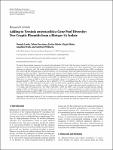Adding to Yersinia enterocolitica Gene Pool Diversity: Two Cryptic Plasmids from a Biotype 1A Isolate
Lepka, Daniela
Kerrinnes, Tobias
Skiebe, Evelyn
Hahn, Birgitt
Fruth, Angelika
Wilharm, Gottfried
We report the nucleotide sequence of two novel cryptic plasmids (4357 and 14 662 base pairs) carried by a Yersinia enterocolitica biotype 1A strain isolated from pork. As distinguished from most biotype 1A strains, this isolate, designated 07-04449, exhibited adherence to eukaryotic cells. The smaller plasmid pYe4449-1 carries five attributable open reading frames (ORFs) encoding the first CcdA/CcdB-like antitoxin/toxin system described for a Yersinia plasmid, a RepA-like replication initiation protein, and mobilizing factors MobA and MobC. The deduced amino acid sequences showed highest similarity to proteins described in Salmonella (CcdA/B), Klebsiella (RepA), and Plesiomonas (MobA/C) indicating genomic fluidity among members of the Enterobacteriaceae. One additional ORF with unknown function, termed ORF5, was identified with an ancestry distinct from the rest of the plasmid. While the C+G content of ORF5 is 38.3%, the rest of pYe4449-1 shows a C+G content of 55.7%. The C+G content of the larger plasmid pYe4449-2 (54.9%) was similar to that of pYe4449-1 (53.7%) and differed from that of the Y. enterocolitica genome (47.3%). Of the 14 ORFs identified on pYe4449-2, only six ORFs showed significant similarity to database entries. For three of these ORFs likely functions could be ascribed: a TnpR-like resolvase and a phage replication protein, localized each on a low C+G island, and DNA primase TraC. Two ORFs of pYe4449-2, ORF3 and ORF7, seem to encode secretable proteins. Epitope-tagging of ORF3 revealed protein expression at 4°C but not at or above 27°C suggesting adaptation to a habitat outside swine. The hypothetical protein encoded by ORF7 is the member of a novel repeat protein family sharing the DxxGN(x)nDxxGN motif. Our findings illustrate the exceptional gene pool diversity within the species Y. enterocolitica driven by horizontal gene transfer events.
No license information

